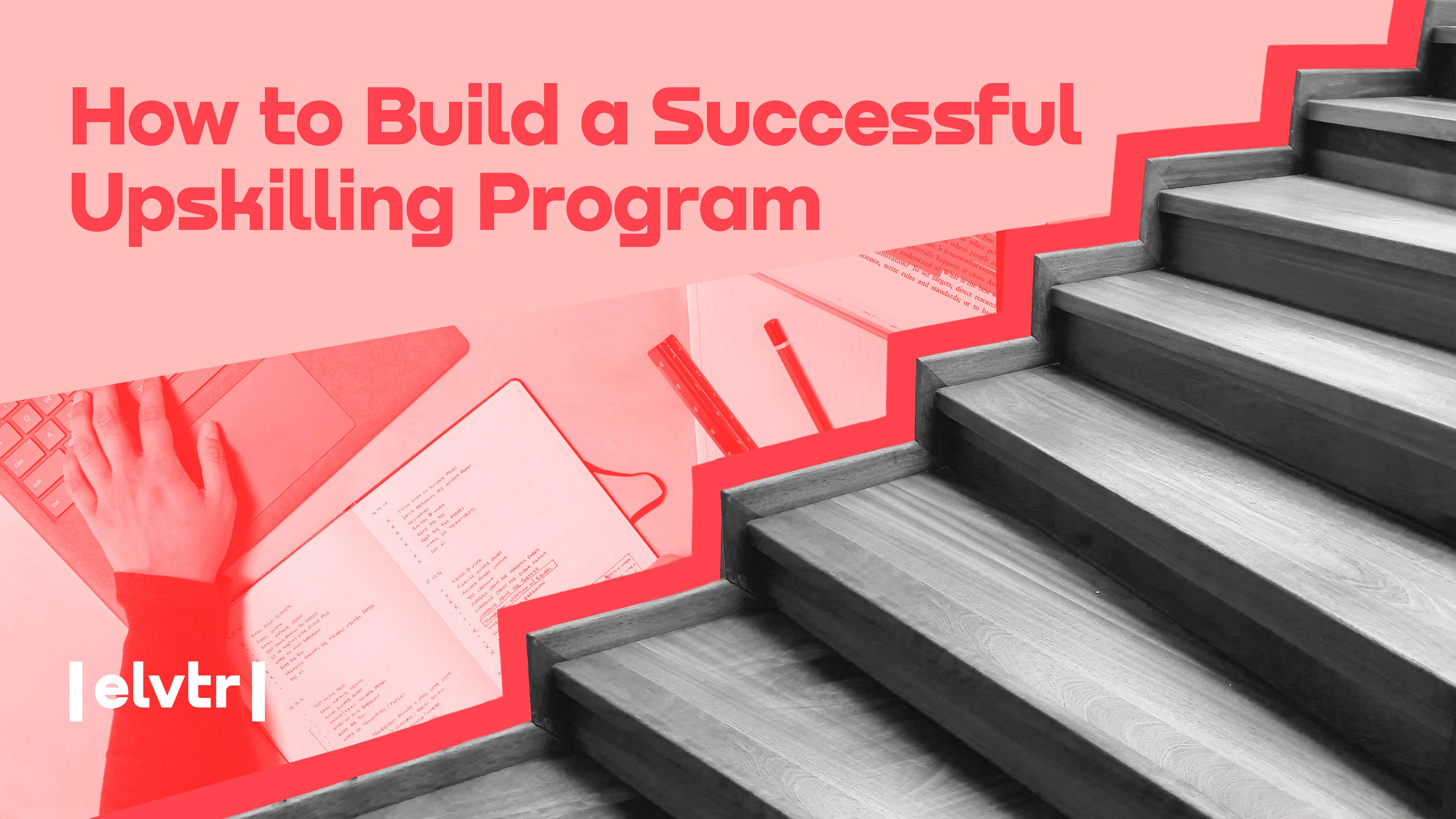- MAIN PAGE
- – elvtr magazine – HOW TO BUILD A SUCCESSFUL UPSKILLING PROGRAM
HOW TO BUILD A SUCCESSFUL UPSKILLING PROGRAM

About upskilling programs
Upskilling is a moderately new term within business and HR circles. It stands for enhancing employees' working abilities.
The times when people got hired and retired at the same job belong in history for some time now. People shift through companies at a pace their parents can't quite understand. There usually comes a moment in one's career when they feel like there isn't much more they can gain from a company, or vice versa. It can be for financial reasons, culture mismatch, or a vague sense of contribution. Sometimes it's for the best, but most of the time, a lot can be done to prevent it for the benefit of all sides. Still, the speed at which things are changing, in tech-related industries particularly, is such that employees are condemned to lag behind if they don't read and learn new things daily.
There are usually three ways for escaping such a trap: hiring, automating, and training existing employees.
The latter corresponds to having a successful upskilling program in place. It means setting up a playing field that empowers employees to get the training they need to gain the skills that business demands.
Therefore, one can define upskilling as enabling employees to raise skills and knowledge in a certain area to a new level. On the other hand, reskilling implies learning new skills to do a different job entirely.
In any case, building such education systems is not that simple. The burning questions include:
- How to recognize the skills a company needs?
- How to awaken and motivate employees?
- How to structure an upskilling program?
- How to measure the upskilling success rate?
How to recognize the skills a company needs?
The company is struggling to hire people with adequate skills or experiencing a competence gap among existing employees.
However, developing and maintaining an upskilling program is a lot more cost-effective than going through the trenches of a hiring process. To make your workforce changes-proof, you need to analyze the skills they currently hold in relation to the business needs. Here's a roadmap:
1. Revisit your organization's strategy
A good strategy will always tell you where you are, where you want to be, and how to get there. Otherwise, following trends and expert reports within the industry can also reveal a lot about the direction you have to take.
2. Identify roles required to fulfill the business goals
Once you determine the company goals, the roles necessary to reach them will disclose by themselves. For example, you may want to expand your business by 30% before the end of the current year. The problem – your workforce is made of subject matter experts and a tiny marketing department. Conclusion – you are thin on sales managers. In summary, now you know your current staff could use an upgrade of their soft and sales skills.
3. Categorize the skills for each role
For some roles, you may naturally know the skills that come with them. For others, you may do your investigative study (Google, LinkedIn, etc.) or refer to a recruitment company.
Once you make a list of skills for different roles, you can further categorize them by type and level of mastery. You will better understand specific roles and set your expectations adequately.
4. Categorize the skills already owned by your employees
Now it's time for a look inward. You can talk to your employees or their direct superiors, observe them at work, examine their latest certifications, do surveys, tests, and other evaluations. The gathered information will expose your starting position.
5. Confront the two categories
Finally, you compare the skills you need with the skills your employees possess. The difference between the two equals a competence gap that you need to bridge.
Recommended courses
How to awaken and motivate employees?
The thing is, most employees are already motivated. They just don't know it yet. They need a spark. Too often, they quietly desire more training and development but struggle to ask for it or recognize where exactly.
Meaningful communication is the key to meeting halfway. It can include setting up weekly 1-on-1 meetings, explaining why you want your employees to do something, listening and giving your full attention, being open for reciprocal feedback, having an open-door policy, etc.
This will enable employees to discuss their professional interests and goals. Absence of such a culture or poor understanding of where employees come from easily results in them leaving and you not knowing why.
When creating an upskilling program, also think of incentives for employee participation. These can include no limits in how many classes to follow, paid afternoon or weekend education, certifications, awards, and similar.
How to structure an upskilling program?
1. Set business and education goals
Both involve setting measurable and attainable goals that determine the educational cycle's value. On each side, such goals can be:
- enlarging the service package,
- reducing service delivery time,
- improving service quality,
- raising the employee level of proficiency,
- adding new skills and responsibilities under employees' belts,
- raising the level of employee engagement, and retention, etc.
2. Define inputs
Once your goals are set, you need to define inputs. In other words, if your goal is to make dinner and decrease hunger, you first need to make sure you have a stove and a pan.
Inputs in upskilling programs primarily relate to people from both instructor and student sides. Instructors may be internal or external, and you could need one or more per course. They need to have the knowledge and be able to pass it on (awaken and motivate). Students wise, how many people on your team do you want to upskill, and what level of competency are they bringing to the table? Answers to such questions will help shape the training course.
Another important input is time – how much of it can your employees spare? How much of it can be taken away from the business day?
3. Design the course
The top five elements of any course are content, duration, location, schedule, and instruction.
The course must have the overall and subtopics worked out, including practical exercises. Employees should have a clear visual of the course path and its milestones. This will positively influence their course grasp and engagement level. Duration-wise, do you need a day, week, or a month-long program, and which would be the wisest? It's the same with the location, schedule, and instruction options.
Overall, each point needs to be very well thought out so that a program can run like a freshly oiled machine. However, building and executing an upskilling program is complex and doesn't come without pitfalls. You must juggle between identifying profitable target audiences, building realistic project scopes, developing the course design, being cost-effective, and keeping stakeholders happy. That's more than enough on anyone's plate.
If you have a skill you wanted to share or have a great idea and think your audience would love it, but you're unsure how to execute it, maybe you could use some upskilling yourself. Instructional design courses can help you identify skill gaps, apply visual and instructional design best practices, and bring decision-makers over to your side.
How to measure the upskilling success rate?
There is no single way to measure the upskilling success rate.
For starters, you can ask the participants how they liked it. This can be done by monitoring their reactions during the course, verbally at the end of the program, or by sending out a survey.
Secondly, you can measure the learning outcome by assessing the employees' knowledge sometime after the course has finished.
Going through a well-designed upskilling or reskilling program should affect the employees' day-to-day behavior and performance. Collect feedback to monitor whether an employee has become more efficient or not.
Finally, upskilling should reflect on the overall project implementation or product/service delivery. Results in the latter can give you an idea of whether upskilling was successful or not.
Top upskilling companies' effort examples
To wrap things up, check out how some of the biggest companies in the world handle upskilling. True, they have unimaginable resources and infrastructure, but you might be just one spark of inspiration away from setting up a quality program yourself.
- Amazon
Amazon's Upskilling 2025 program includes: helping employees with technology and coding backgrounds develop skills in machine learning, training non-technical employees with the basic skills to shift into software engineering careers, training and certification to tighten the cloud skills gap in the industry.
Apart from enabling new knowledge and skills, Amazon encourages employee participation by paying up to 95% of tuition and fees. - PwC
In 2019 PwC invested $3 billion to upskill and retrain all 275.000 employees over 3-4 years.
Business Insider reported that the investment was made to take employees away from clients and put them in classrooms, develop digital training tools, deploy employees to community projects, and utilize existing partnerships with the United Nations and World Economic Forum to help adapt the training to each of their markets. - IBM
IBM used AI to identify upskilling strategies and assist those who may become obsolete due to technological upgrades. Their SkillsBuild platform identifies skills and employment opportunities for members of disadvantaged communities. - Mastercard
Mastercard's learning platform Degreed offers personalized learning experiences. After launch, around 60% of the company's workforce used the platform, with the usage rate rising to 96% during the pandemics.
In conclusion, we leave you with this – to be or not to be, to upskill or not, should be out of the question.
*ELVTR is disrupting education by putting proven industry leaders in a virtual classroom with eager rising stars. ELVTR courses offer 100% instructor driven content designed to give you practical knowledge within a convenient time frame. Choose the right course for you!

